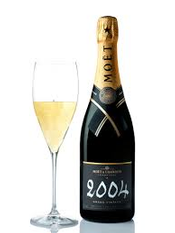Moët & Chandon, Champagne (France) “Grand Vintage” 2004 (Moët-Hennessy USA Inc., $58): A couple of years ago, I shared lunch with Benoît Gouez, Chef de Cave of the Champagne giant, Moët & Chandon. What I heard and tasted that day turned upside down some of my long-held beliefs about Moët’s best-selling Champagnes. The wines  were going dryer. The Vintage Champagnes were assuming a stronger importance in the company’s range. The Extra Dry (slightly sweet) White Star, which was the leading Champagne in U.S. sales, was history.
were going dryer. The Vintage Champagnes were assuming a stronger importance in the company’s range. The Extra Dry (slightly sweet) White Star, which was the leading Champagne in U.S. sales, was history.
That day I also saw the dramatic new label for Moet’s vintage-dated Champagnes, on which the vintage year dwarfs the company name itself. It was gorgeous and it seemed to symbolize a new direction for what the company is now calling its Grand Vintage bottlings.
Now, Moët & Chandon has released two new Champagnes in the Grand Vintage line, the 2004 and the 2004 Rosé. Both are very fine and are good value for the serious quality they represent.
Of the two, my preference is the white. When I tasted this 2004 Grand Vintage recently, it surprised me in two ways: it is quite dry, and it is very evocative of fruits. Judging by the aroma alone — showing notes of pear, lemon, white peach and other fruits mingling with floral honeysuckle — I thought that I could have a New World bubbly in my glass. But structurally the wine is classically lean and firm, creating a whole that is as serious as it is flavorful. As I continued to taste, I felt that the wine was playing with me, one moment showing delicious ripe fruit flavors and creamy texture, the next moment going firm and taut, its appealing flavors concentrated within a mesh of acidity and minerality. The backdrop of it all is the dryness, only 5 grams/liter of residual sugar, while regulations permit up to 12 grams and until recently permitted up to 15 grams. I came to the conclusion that it was the lack of sweetness that makes the delicate fruitiness so apparent.
Because of the wine’s lack of developed flavors such as caramel or nuttiness, I was surprised to realize that this wine had spent seven years aging en tirage (bottle-aging before disgorgement). Seven years is serious time for a Champagne that is not a luxury tête de cuvée; the average is three to four years. That the primary fruitiness could endure, and the wine remain so youthful, is impressive.
Red grapes dominate the blend of Moët ’s 2004 Grand Vintage (Pinot Noir at 33 percent and Pinot Meunier at 29 percent) but the Chardonnay component, 38 percent, is unusually high for a Moët blend — an adaptation, no doubt, to the particularities of the mild, warm 2004 season and the abundant ripe, healthy grapes it produced.
Benoît Gouez told me, “Even in Champagne, people don’t know and understand what a Vintage Champagne is.” I figure that’s the thinking behind the label graphics. This 2004 is not just the latest iteration (the 70th, to be precise) of vintage Moët & Chandon Champagne; it is an expression of 2004, produced by Moët. A very pretty, delicate and appealing Champagne, and no less serious for that.
92 Points
